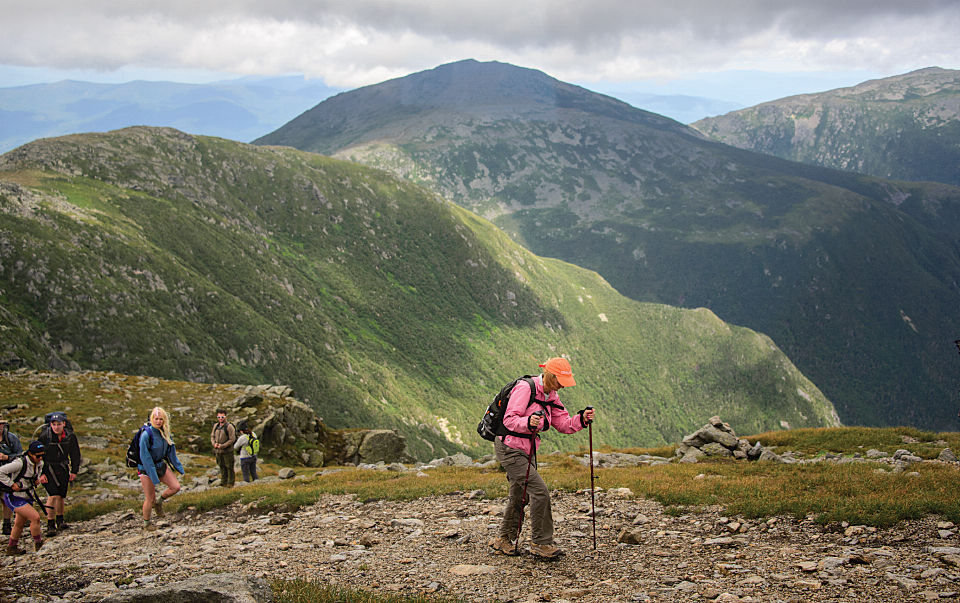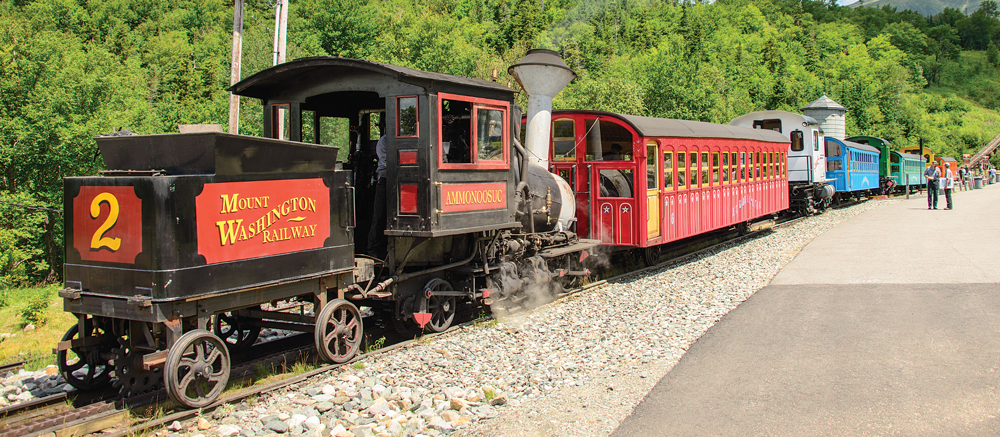Completed in 1869, the Mount Washington Cog Railway was the first of its kind. Riding the rails to the top of New England’s highest peak in this engineering marvel is a trip back in time
The bright-red coach of the Mount Washington Cog Railway train glinted in the early morning sun as it chugged up  to the boarding platform from its overnight base camp below. A crowd of grinning passengers eagerly awaited its arrival, and we laughed in delight when the engine’s shrill horn pierced the air, sending a burst of white steam from its whistle.
to the boarding platform from its overnight base camp below. A crowd of grinning passengers eagerly awaited its arrival, and we laughed in delight when the engine’s shrill horn pierced the air, sending a burst of white steam from its whistle.
The engine heaved and coughed and sputtered as it inched toward us, clouds of steam billowing out from beneath its wheels. At the front of the coach, wearing a classic conductor’s hat and vest, the brakeman beamed and waved, as though reaching out to us from another era. With cell phones and selfie sticks held high to capture the moment, the crowd was instantly swept up in a magical mirage that transported us across nearly 150 years from our Internet Age to the peak of the Railway Age.
Back in the summer of 1869, the unique cog railway became the first train ever to climb straight up the side of a mountain. With an elevation of 6,288 feet, New Hampshire’s Mount Washington is the tallest peak in the Northeastern United States, and despite legions of naysayers and railroad barons who deemed the project impossible, Sylvester Marsh, the visionary behind this Little Engine That Could, pursued his dream and designed a train that could literally claw its way up the steepest slopes.
Marsh was an ambitious New Hampshire native who, as a teenager, had walked 117 miles to Boston to seek his fortune. He later found both great riches and extraordinary success in the burgeoning town of Chicago, which, upon his arrival in 1833, had a population of just 300. Beginning in meat packing and moving on to the grain industry, Marsh was an inventor to the core. His creative mind brought him 11 patents in his lifetime, six of which were for machinery used in drying grain, a process that made it possible to ship American wheat, corn, oats and barley to Europe and ultimately helped put Chicago and the Bread Basket states on the map.
Wealthy yet still in his prime years, Marsh tried to retire at age 52, but inactivity didn’t agree with him. On a hike up Mount Washington with a friend in 1857, his passion for invention was fueled once again. The summit was accessible only on foot in those days, and the mountain took the lives of more than a few adventurers who dared hike to the top. Marsh barely made it himself, battling ferocious weather near the peak. Reaching the hiking hut called Tip Top House, he watched the next morning dawn in spectacular color with jaw-dropping views, the likes of which few people in those days would ever see, and vowed to bring the railroad to the top of this mountain and make it possible for city folk from Boston and New York to witness the stunning beauty, too.
Our train breathed noisily, snorting big puffs of steam as we all climbed aboard, and in no time we were off on an hour-long 3-mile journey up this fearsome mountain. Marsh’s clever invention uses a third-rail ladder track that runs between the two standard train tracks. Functioning like a bicycle chain laid out on the ground, the teeth on two big cogs in the center of the train engine and coach car grab onto the ladder track and pull the train up. The regular train wheels simply roll along for the ride.
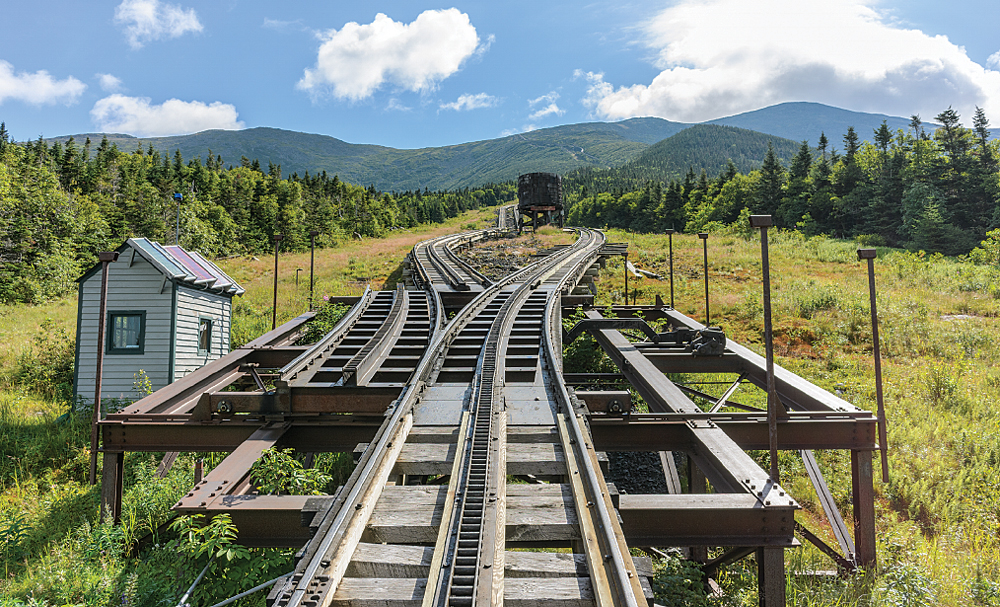
Switching tracks makes it possible for trains to pass each other on the way up and down the mountain.
Our brake operator, Kelly, told us all about the train, now a National Historic Engineering Landmark, while we watched wide-eyed as the incline became ever steeper in front of us and the views into the valley expanded behind us. It was easy to imagine the thrill that late-19th-century New Yorkers must have felt when they boarded a train at Grand Central Station, their bags checked through to the Summit House hotel on top of Mount Washington, and then rode the last 3 miles of their two-day journey up into the clouds.
Halfway up the mountain, the train stopped, and Kelly explained that the train was taking on another 300 gallons of water from a mountain spring that would get us through the toughest climbs ahead. The railroad’s steepest incline is at Jacob’s Ladder, a fantastic elevated trellis that soars high above a valley between two peaks and climbs a grade of 37.4 percent. As we chugged through this portion of the ride, the fireman shoveled coal from a huge hopper into the boiler as fast as he could, and clouds of black smoke filled the air.
Soon, we were above the tree line, and the peaks of the White Mountains filled our view in every direction. Suddenly, we saw a long line of hikers approaching on a trail. We waved, and they stopped to take photos of us as we passed. These hardy people were trekking to the summit with backpacks, hiking boots and walking sticks, while we had taken the easy way. When the train stopped at the top and let us off, we rushed to the sign that marks the summit along with all the hikers so we could get selfies by the sign, too. The hikers might have had more bragging rights for reaching this spot, but I sus- pect we had more fun.
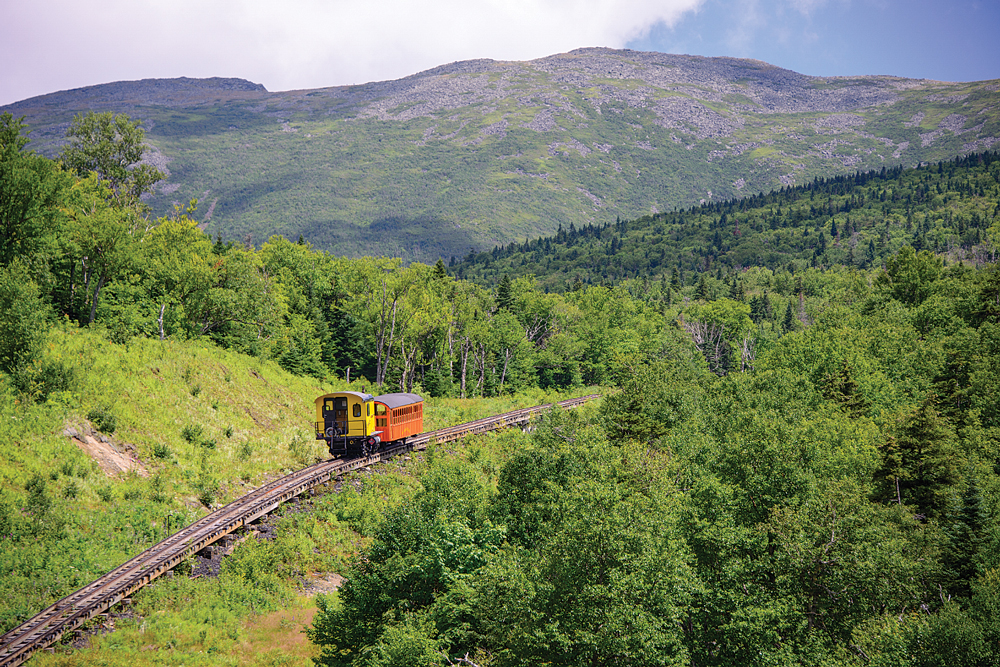
The once-a-day steam-engine trip is pure 1875 technology, while the quieter and quicker biodiesel engines (above) take riders up the mountain with the latest in cog-rail engineering.
Mount Washington sits in a pre-carious position on the planet where weather systems go through a funneling effect that intensifies their ferocity as they approach the mountain, and it is impossible to predict what the weather will be at the top when you board the train at the bottom. As we walked around the summit, we were glad we’d brought warm sweatshirts, as the entire mountaintop was socked in with pea-soup fog. So much for experiencing the stunning views that inspired Sylvester Marsh to build his railroad! The moodiness of this fickle mountain is legendary, and the cold, wet wall of white mist on this sunny midsummer day gave us an appreciation of just what the weather might be like in more dismal conditions.
Around the time the cog railway was beginning to bring tourists up to the summit of the mountain, the U.S. Signal Service, the predecessor of the National Weather Service, established a manned weather station on the peak, and scientists began studying the variable moods of this notoriously menacing mountain.
On April 12, 1934, wind speeds on the summit were measured at 231 mph, the highest the world had ever seen. A local legend claims that the wind speed gauge was blown right off the top of the mountain, but the truth is that the scientists were there, huddled inside the weather station, and one brave soul went out to take a reading on the firmly affixed instrument and saw the conditions with his own two eyes. In 1996, that max wind speed was handily topped inside the eye wall of Hurricane Olivia at Barrow Island in Australia, but it was recorded by an unmanned weather station, which is not quite the same thing.
The Mount Washington Observatory is a scientific complex, operated 24/7 by meteorologists, physicists and other scientists. In addition to studying the weather, the observatory offers all kinds of educational opportunities, including live-in volunteer positions. The facility also offers tours, and we were thrilled to take one, given by Kaitlyn O’Brien, and be shown the myriad of sophisticated equipment that records every imaginable weather-related statistic, day in and day out, as well as the
dormitory-style residential quarters where the scientists and volunteers live.
The key wind gauges sit on the roof of the observatory, and our guide led us up through a series of steep ladders and hatches to make our way out onto the roof. On a sunny day, I’m sure the views from this vantage point are sensational, but we hugged our arms tightly to our chests in the fog and shivered as she pointed out two vanes that continuously record wind speeds. The wind was not that high as we stood there, but we got a kick out of seeing much more accelerated speeds on the observatory’s webcam during winter storms after our visit.
As we emerged from the observatory’s Extreme Mount Washington museum, our heads spinning with thoughts of harrowing storm systems, the fog began to lift, and we heard the welcoming sound of our train’s whistle. We had been mingling with people who had reached the summit of Mount Washington on foot via hiking trails and by car via the toll road, but now we and our fellow railway passengers came from all corners of the summit’s many buildings to hustle back onto the train.
Kelly took her position at the front of the coach and began to guide us down the mountain. Marsh’s engine design places the engine below the coach at all times, so there is no need to turn the train around at either the top or bottom of the track. While the train ascends, the engine pushes the passenger coach up the mountain. As it descends, the engine and coach coast down together, relying on the engine’s compression brakes, controlled by the engineer, and the coach’s disc brakes, controlled by the brakeman, to slow the whole thing down. While Kelly had an easy job on the way up and could tell us all about the train and the mountain, she was a busy woman on the way down.
She had two big wheels in front of her, and she feathered the brakes to keep the coach from bumping the engine ahead of us, as we traveled down the mountain. One wheel put the brakes on hard, while the other was for fine-tuning. The train was now pitched very far forward, so Kelly had to lean back quite a bit to keep standing upright. Kids on the train hopped out of their seats to experience the weird sensation of standing at such an angle, too. At one point, the rear end of the coach was 14 feet above the front end of the coach, and it was amusing to walk uphill and down in the aisle from one end of the coach to the other.
Marsh’s invention spawned lots of imitators worldwide. Swiss engineers copied his designs in the 1870s and improved upon them, ultimately developing a cog railway that chugs up a 48 percent grade in Switzerland. Another famous American cog railway climbs Pikes Peak in Colorado. However, Marsh was the visionary who imagined the concept and saw it through, and his tradition of innovation carries on at the Mount Washington Cog Railway to this day.
The cog railway has been owned by two couples since 1983, and they have invested heavily in exploring new technologies for their trains.
The latest innovation is a new engine that runs on biodiesel that they intro-duced in their 25th year of stewardship of the railway. The steam train now runs once a day, first thing in the morning, while the rest of the trains that roll up and down the mountain all day long are fueled by biodiesel.
With only one track, the original railway had no way for trains to pass each other. Since then, supplemental tracks with switching stations were built to allow multiple trains to ride the rails. As we rolled downhill, we could see another train approaching on its way up. Soon, we were side by side at the switching track, and we took photos of each other out the windows.
We arrived at the bottom of the mountain totally exhilarated. This is a ride that brings out the kid in everyone, and we had been utterly enchanted by the experience. For RV travelers planning a road trip in the northeast, the Mount Washington Cog Railway offers a wonderful immersion in America’s railway history on a special excursion to the peak of New Hampshire’s White Mountains.
Summiting the Northeast’s Highest Peak
Mount Washington Auto Road
Open from late May through late October, the privately owned toll road ascends the east side of Mount Washington, departing from Route 16 in Pinkham Notch. RVs and some pickups with large cabs and/or dual rear wheels are not permitted. Check the website for full restrictions.
603-466-3988 | www.mtwashingtonautoroad.com
Mount Washington Cog Railway
Open from late April through November, the historic cog railroad ascends the west side of Mount Washington. From Route 302 in Bretton Woods, take Base Station Road and follow it 6 miles to the station. Plan to arrive 30 minutes before the scheduled departure to allow plenty of time for ticketing.
800-922-8825 | www.thecog.com
Mount Washington Observatory
Open when the cog railroad is running, the Extreme Mount Washington museum and weather station are housed in the state park visitor center at the summit. The affiliated Weather Discovery Center is located in North Conway Village on State Route 112.
603-356-2137 | www.mountwashington.org
Tuckerman Ravine Trail
Among the many hiking routes leading to the summit of Mount Washington, the 4.2-mile Tuckerman Ravine Trail up the peak’s east side is the most popular. Starting at the Pinkham Notch Visitor Center, the trail starts off easy and gets steep toward the end. From the trailhead to the top and back, the day hike takes from five to nine hours.
RV Camping in Northern New Hampshire
Lancaster
Mountain Lake Campground and RV Park
603-788-4509 | www.mtnlakecampground.com
Littleton
Crazy Horse Campground and RV Park
800-639-4107 | www.crazyhorsenh.com
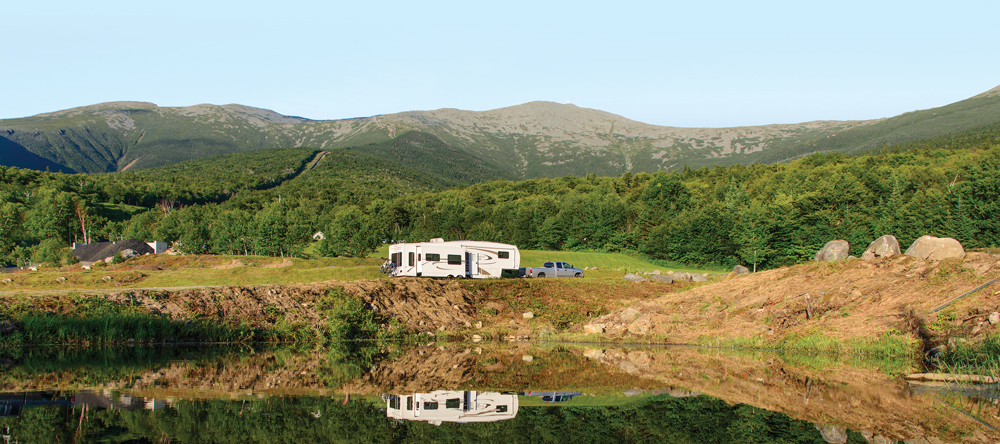
With countless hiking, biking, sightseeing and camping opportunities, New Hampshire’s White Mountains are an outdoor playground for RVers.
North Conway
Saco River Camping Area
603-356-3360 | www.sacorivercampingarea.com
Shelburne
Timberland Campground
603-466-3872 | www.timberlandcampgroundnh.com
Twin Mountain
Beech Hill Campground
603-846-5521 | www.beechhillcampground.com
Tarry Ho Campground
603-846-1026 | www.tarryho.com
 Trailer Life columnist and frequent contributor Emily Fagan has traveled full time by RV and sailboat with her husband, Mark, since 2007. The couple’s photos have appeared on more than 25 magazine covers and wall calendars, and Emily’s lifestyle, travel and how-to articles have been featured in more than a dozen RV and sailing publications. Follow their adventures on their blog, Roads Less Traveled.
Trailer Life columnist and frequent contributor Emily Fagan has traveled full time by RV and sailboat with her husband, Mark, since 2007. The couple’s photos have appeared on more than 25 magazine covers and wall calendars, and Emily’s lifestyle, travel and how-to articles have been featured in more than a dozen RV and sailing publications. Follow their adventures on their blog, Roads Less Traveled.


